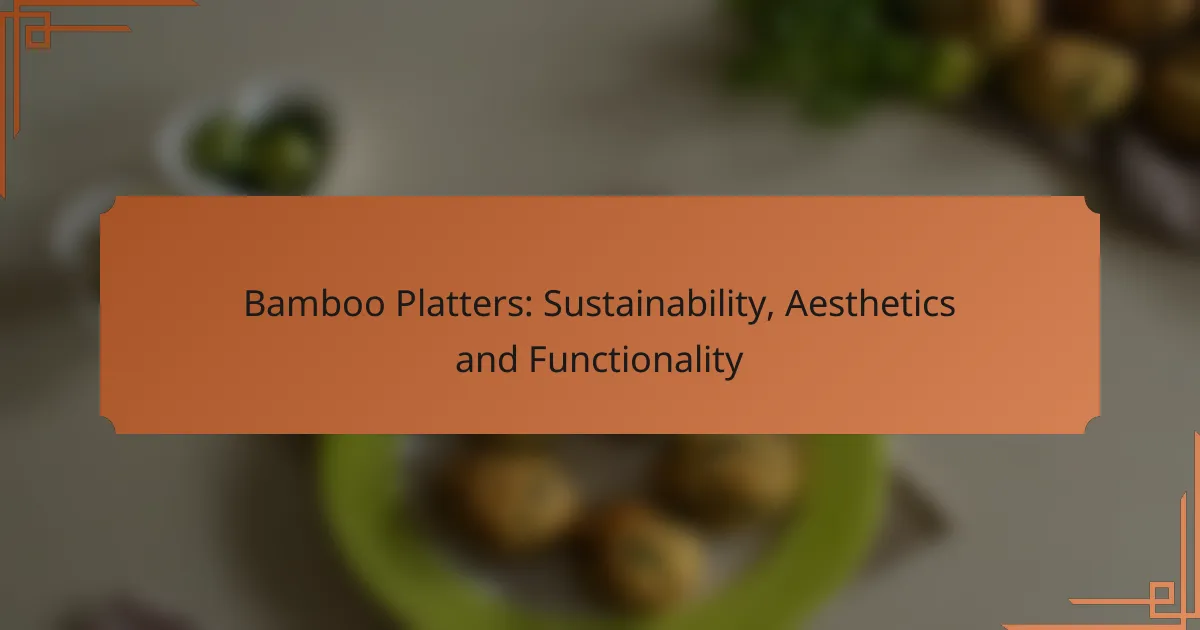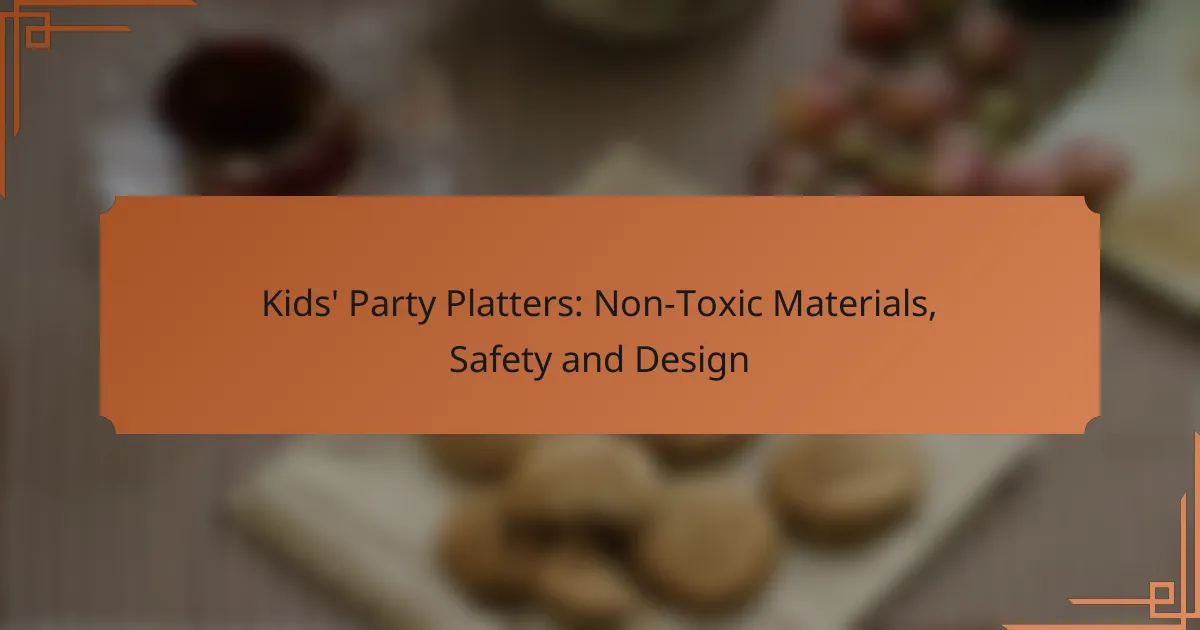Melamine platters are popular in food service due to their lightweight design and aesthetic appeal, but it’s crucial to ensure they meet specific safety standards for food contact. These standards help prevent chemical leaching and ensure material safety, especially when in contact with heat or acidic foods. When selecting melamine platters for restaurants, prioritize products that are certified and free from harmful chemicals to guarantee their suitability for food service use.

What are the safety standards for melamine platters in food service?
Melamine platters used in food service must meet specific safety standards to ensure they are safe for food contact. These standards address potential chemical leaching and overall material safety, particularly when exposed to heat or acidic foods.
FDA regulations on melamine
The U.S. Food and Drug Administration (FDA) regulates melamine as a food contact substance. Melamine must comply with FDA guidelines that limit the amount of melamine and formaldehyde that can migrate into food. Manufacturers must demonstrate that their products are safe for intended use, particularly regarding temperature and food type.
It is crucial for food service operators to source melamine platters from suppliers who provide documentation of FDA compliance. Regular audits and checks can help ensure ongoing adherence to these regulations.
California Proposition 65 compliance
California Proposition 65 requires businesses to provide warnings about significant exposures to chemicals that cause cancer, birth defects, or other reproductive harm. Melamine platters may fall under this regulation if they contain substances that exceed safe levels. Manufacturers must ensure their products are compliant to avoid legal repercussions.
Food service establishments in California should verify that their melamine platters come with appropriate Prop 65 warnings if necessary. This can help avoid potential fines and enhance customer trust.
ASTM standards for food contact materials
The American Society for Testing and Materials (ASTM) has established standards that apply to food contact materials, including melamine. These standards focus on the safety and performance of materials when in contact with food, addressing aspects such as chemical migration and mechanical properties.
Food service operators should look for melamine platters that meet relevant ASTM standards, as this indicates a level of safety and quality assurance. Regularly reviewing supplier certifications can help maintain compliance and safety in food service operations.

How to choose safe melamine platters for restaurants?
To choose safe melamine platters for restaurants, focus on selecting products that meet safety standards and are free from harmful chemicals. Look for certifications and reputable brands to ensure the platters are suitable for food service use.
Material certifications to look for
When selecting melamine platters, check for certifications such as FDA approval and NSF International certification. These indicate that the products have been tested for safety and are compliant with food safety regulations.
Additionally, look for labels that specify the absence of harmful substances like BPA and formaldehyde. This ensures that the platters are not only safe for food contact but also durable for repeated use in a restaurant setting.
Recommended brands for safety
Some well-regarded brands known for producing safe melamine platters include Cambro, Carlisle, and Tablecraft. These brands consistently meet safety standards and offer a variety of designs suitable for different dining environments.
Before purchasing, read reviews and check for any recalls or safety notices related to specific products. This can help you avoid brands that may have had issues with safety compliance in the past.

What are the benefits of using melamine platters in food service?
Melamine platters offer numerous advantages in food service, including their lightweight nature and aesthetic appeal. They are designed to withstand the rigors of daily use while maintaining an attractive presentation for various dishes.
Durability and break resistance
Melamine platters are highly durable and resistant to breaking, making them ideal for busy food service environments. Unlike traditional ceramic or glass dishes, melamine can withstand drops and impacts without shattering, reducing the risk of injury and the need for frequent replacements.
This durability is particularly beneficial in settings like restaurants and catering services, where accidents can happen. Choosing melamine helps ensure that your serving ware remains intact even under heavy use.
Cost-effectiveness compared to porcelain
Melamine platters are generally more cost-effective than porcelain, making them a smart choice for food service operations. The price of melamine dishes typically falls within a lower range, allowing businesses to save on initial investments while still providing an attractive presentation.
Additionally, the longevity of melamine means that operators can avoid the costs associated with frequent replacements, which is common with porcelain that can chip or break easily. This combination of affordability and durability makes melamine a practical option for food service providers looking to manage their budgets effectively.

What are the risks associated with melamine platters?
Melamine platters can pose several risks, particularly related to chemical safety and temperature limits. Understanding these risks is crucial for safe food service use.
Potential chemical leaching
Melamine is a type of plastic that can leach harmful chemicals into food, especially when exposed to high temperatures or acidic substances. This leaching can lead to health concerns, particularly if the platters are used for hot or acidic foods like tomato sauce or citrus dishes.
To minimize risks, avoid using melamine platters in situations where they will come into contact with high-temperature items or acidic foods. Opt for alternatives like glass or ceramic for these applications.
Temperature limitations
Melamine platters are not designed for use in high-temperature environments, such as ovens or microwaves. Exceeding recommended temperature limits can cause the material to warp or degrade, potentially releasing harmful substances.
Generally, melamine platters should be limited to temperatures below 70°C (158°F). Always check the manufacturer’s guidelines for specific temperature recommendations to ensure safe usage.

How to properly care for melamine platters?
To properly care for melamine platters, it’s essential to follow specific cleaning and storage practices that enhance their durability and maintain their appearance. Regular maintenance can prevent scratches and discoloration, ensuring they remain safe for food service use.
Cleaning guidelines for longevity
When cleaning melamine platters, avoid abrasive cleaners and scrubbers that can damage the surface. Instead, use a mild detergent and a soft sponge or cloth to gently wipe them down. For stubborn stains, soaking in warm soapy water for a short period can help lift the residue without harming the material.
It’s advisable to wash melamine platters by hand rather than in a dishwasher, as high temperatures can warp or degrade the material over time. If you must use a dishwasher, place them on the top rack and select a gentle cycle.
Storage tips to prevent damage
To prevent damage when storing melamine platters, stack them carefully to avoid scratching the surfaces. Placing a soft cloth or paper towel between each platter can provide additional protection against scratches and chips.
Store melamine platters in a cool, dry place away from direct sunlight to prevent fading and warping. Avoid heavy stacking, as excessive weight can lead to deformation. Regularly inspect stored platters for any signs of wear or damage to ensure they remain safe for food service use.

What are the alternatives to melamine platters?
Alternatives to melamine platters include various materials that offer safety and compliance for food service use. Options such as biodegradable materials, glass, and ceramic can provide effective solutions while addressing environmental concerns and health regulations.
Biodegradable options
Biodegradable platters are made from materials like bamboo, palm leaves, or sugarcane. These options break down naturally over time, reducing environmental impact compared to traditional plastics. They are suitable for single-use applications and are often compostable, making them a sustainable choice for food service.
When selecting biodegradable options, consider their durability and resistance to moisture, as some may not hold up well with wet or hot foods. Always check for certifications that confirm their compostability, such as ASTM D6400 or EN 13432.
Glass and ceramic alternatives
Glass and ceramic platters are durable, reusable, and often aesthetically pleasing, making them popular in restaurants and catering. They are non-toxic and do not leach chemicals into food, ensuring safety during service. Additionally, these materials can withstand high temperatures, making them suitable for hot dishes.
However, glass and ceramic can be heavier and more fragile than melamine, requiring careful handling to avoid breakage. Consider investing in tempered glass or stoneware for added strength and longevity, especially in high-traffic food service environments.

What trends are emerging in melamine platter design?
Melamine platter design is increasingly focused on sustainability, customization, and aesthetic appeal. These trends reflect a growing demand for eco-friendly materials and unique branding opportunities in the food service industry.
Eco-friendly melamine innovations
Recent innovations in melamine production emphasize the use of recycled materials and sustainable manufacturing processes. Many manufacturers are now creating melamine platters that are free from harmful chemicals, such as BPA, and are compliant with food safety regulations.
Additionally, some brands are exploring biodegradable alternatives to traditional melamine, which can reduce environmental impact. These eco-friendly options are becoming more popular among restaurants and catering services that prioritize sustainability.
Customizable designs for branding
Customizable melamine platters allow businesses to showcase their brand identity effectively. Restaurants can incorporate logos, colors, and unique designs that align with their overall theme, enhancing customer experience and recognition.
Many suppliers offer options for custom printing or engraving, making it easy for food service providers to create a cohesive look. This trend not only boosts brand visibility but also adds a personal touch to the dining experience.

How do melamine platters compare to other serving ware?
Melamine platters are a popular choice in food service due to their durability and lightweight nature, making them a practical alternative to traditional ceramic or glass serving ware. They are less prone to breaking and can withstand heavy use, but considerations around safety and compliance are essential when choosing them for food service.
Durability and Weight
Melamine platters are significantly more durable than glass or ceramic options, which can shatter easily. They are lightweight, making them easier to handle, especially in busy food service environments. This combination of durability and weight makes melamine an ideal choice for outdoor events and catering services.
Safety and Compliance
When using melamine platters, it’s crucial to ensure they meet safety standards, particularly regarding food contact. In the United States, melamine products must comply with FDA regulations, which limit the amount of melamine that can leach into food. Always check for certifications to ensure the platters are safe for serving food.
Cost-Effectiveness
Melamine platters are typically more affordable than high-quality ceramic or glass serving ware. Prices can vary widely, but melamine options often fall within the low to mid-range, making them accessible for restaurants and catering businesses. Their longevity also contributes to cost savings over time, as they require less frequent replacement.
Design and Aesthetics
Melamine platters come in a variety of designs and colors, allowing for creative presentation options in food service. While they may not have the same upscale appearance as fine china, many modern melamine products mimic the look of traditional serving ware. This versatility makes them suitable for casual dining settings as well as more formal occasions.



